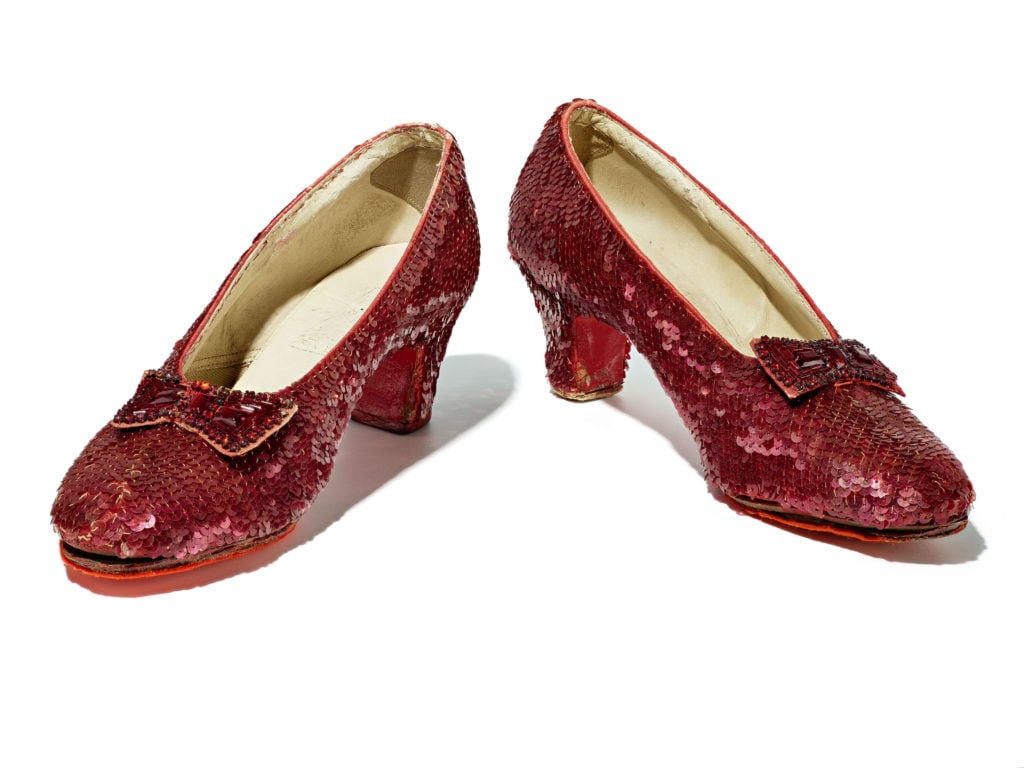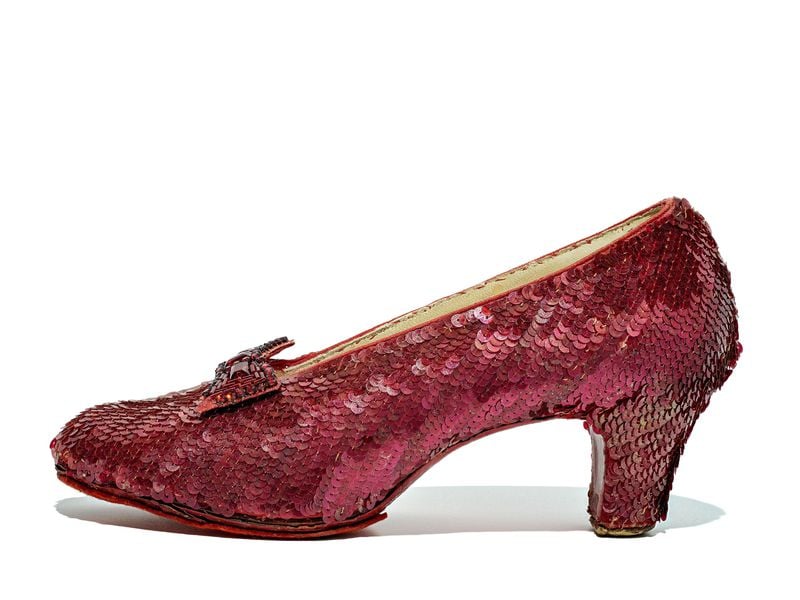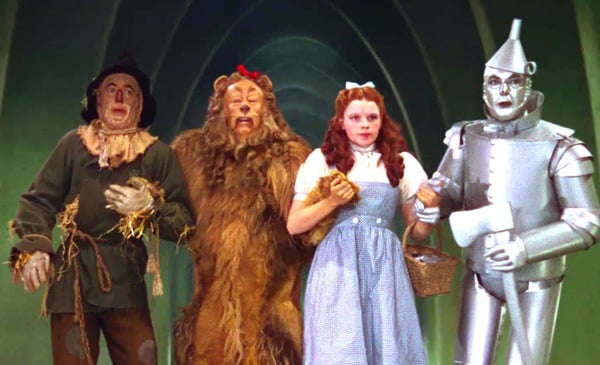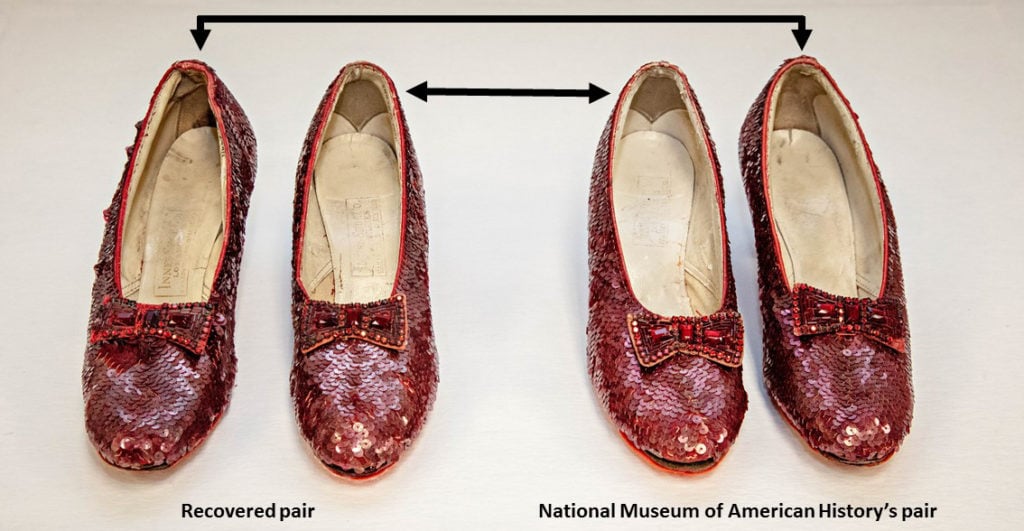Art World
The Smithsonian Unveils a Painstakingly Restored Pair of Dorothy’s Famous Ruby Slippers From ‘The Wizard of Oz’
The repairs cost over $300,000 and took 200 hours to complete.

The repairs cost over $300,000 and took 200 hours to complete.

Sarah Cascone

Dorothy’s Ruby Slippers are having a moment. After two years of conservation efforts, the Smithsonian’s National Museum of American History in Washington, D.C., is ready to unveil the newly restored shoes from The Wizard of Oz, which go on view today in a gallery designed to look like the Emerald City. Serendipitously, the museum also played a role in authenticating a second pair of shoes from the film, stolen from the Judy Garland Museum in Grand Rapids, Minnesota, in 2005 and recently recovered by the FBI.
“It was always one of those things, ‘Oh, wouldn’t it be neat if they found the other pair of Ruby Slippers?’” Smithsonian objects conservator Dawn Wallace told Smithsonian Magazine. “And then when you find out that they did, and you actually get to participate in the recovery and the whole process of returning these iconic items, [it is] almost like an Indiana Jones moment.”
There are five known pairs of Ruby Slippers created for the movie by MGM Studios’ chief costume designer Gilbert Adrian (1903–1959). He used white pumps, covering them in red fabric and painting the soles red before adding sequins and beaded bows. To fit the diminutive feet of 16-year-old Judy Garland (1922–1969), they were only a size five.
After production on the 1939 film wrapped, most of the shoes went into storage at MGM, where they remained until 1970 when a company costumer, Kent Warner, stumbled upon them. One pair he kept for himself, a second was sold to collector Michael Shaw along with other film costumes for $2,000, and actress Debbie Reynolds snapped up the third, a slightly different pair used for screen tests, for just $300. The fourth went to auction, selling for $15,000.
In 1979, the auction pair was anonymously donated to the Smithsonian. They’ve been a favorite of visitors to the institution ever since, seen by tens of millions of people, according to an estimate from Ryan Lintelman, the museum’s curator of entertainment. (A woman from Tennessee came forward at the time of the auction with the fifth known set, which she won in a contest as a teenager at the time of the film’s release.)

Dorothy’s ruby slippers from the 1939 film The Wizard of Oz. Courtesy of the Smithsonian.
When Shaw’s pair was stolen in 2005, it made headlines. An anonymous donor even offered a $1 million reward in exchange for information leading to their return.
The market for the shoes has exploded in recent decades. Reynolds sold her pair privately in 2011 for $627,300. The Academy Museum of Motion Pictures, set to open in 2019, picked up Warner’s pair for a cool $2 million in 2012, with the help of Leonardo DiCaprio. And last year, a group of collectors and investors that bought the contest prize shoes for $666,000 in 2000 put them back on the market for a $6 million price tag. (As of yet, a buyer has not materialized.)
There’s a reason that Dorothy’s Ruby Slippers loom so large in the public imagination: “The Wizard of Oz is America’s only true original fairy tale,” explained Rhys Thomas, author of the comprehensive 1989 book The Ruby Slippers of Oz to Smithsonian Magazine. “Then you combine it with star power, Judy Garland… and you get an iconic piece of cultural heritage. People just won’t let go of it.” He likened them to the “Holy Grail” of American cinema.

A scene from The Wizard of Oz. Courtesy of MGM.
After 80 years, however, the Smithsonian’s shoes were showing signs of wear. In 2016, the museum launched a Kickstarter campaign, raising nearly $350,000 to #KeepThemRuby, as its hashtag proclaimed. The ambitious conservation project was complicated by the many materials in each of the 2,400 or so sequins on each shoe: “a gelatin core, silver lining, cellulose nitrate coating and dye in the coating,” as per Smithsonian.
The work took 200 hours and was done under a microscope, each sequin carefully cleaned and re-secured to the shoe in the case of lose, fraying, or broken threads. The museum believes it was the most extensive conservation job in the shoes’ history.
After such painstaking work, it was easy for the team at the Smithsonian to quickly determine that the shoes the FBI found were the real deal. The materials were consistent in both, with matching clear glass beads that had been painted red on the shoes’ bows. Interestingly, museum staff soon came to realize that the two sets were actually a mismatched pair, the left and right shoes accidentally swapped in a mixup that likely happened during filming.

The Ruby Slippers recovered by the FBI and the Ruby Slipper’s in the museum’s collection are mismatched twins. Photo courtesy of the Smithsonian.
Now that they are back on view, the shoes have a new temperature-controlled, alarmed display case that filters pollutants. It is located in the museum’s newly renovated Gateway to American Culture wing.
In the new exhibition, along with the Ruby Slippers, guests can see the hat worn by Ray Bolger’s Scarecrow, donated to the museum by his wife back in 1987; and the wand used by Glinda the Good Witch, played by Billie Burke. It’s all displayed against a backdrop of a field of poppies, designed by local art and design firm No Kings Collective.
The movie was an adaptation of L. Frank Baum’s (1856–1919) fantasy novel The Wonderful Wizard of Oz, published in 1900. One major change between the two? In the original book, Dorothy wore Silver Shoes. Eager to show off their new Technicolor technology, the filmmakers opted for a more colorful alternative—one of the most fortuitous decisions in movie-making history.